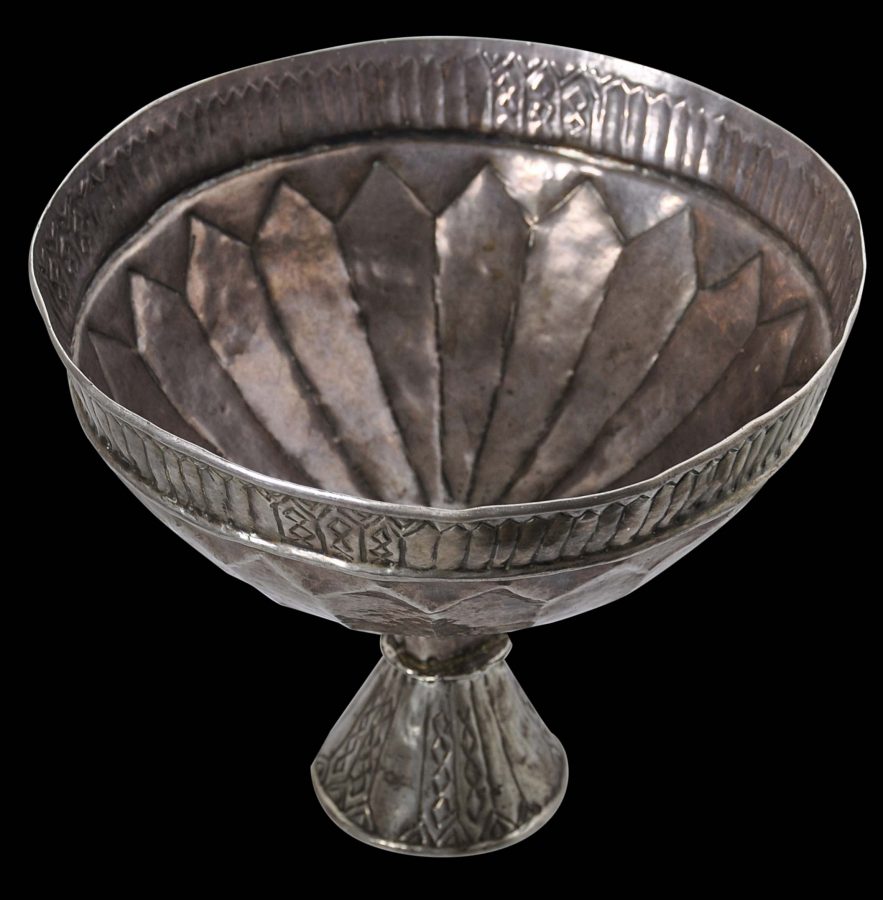This large silver ritual wine chalice is from the Nuristan region of Afghanistan’s North-West Frontier. It is of beaten and engraved high-grade silver. It has a flared foot, a small, unadorned stem, and a large bowl decorated with a wide border of lotus petals and an upper register of geometric patterns. The construction is rudimentary: the base and stem have been sedged together with wire and the stem has been riveted to the bowl with silver rivets.
Its form very much reflects the East-West, Gandharan and Silk Road nature of many objects from this region. The form of the chalice has an early medieval European feel perhaps reflecting Hellenistic influence arising from Alexander the Great’s incursions into the region, but perhaps also the form of an over-sized porcelain stem cup associated with China’s Tang Dynasty. The lotus petal patterning about the bowl also suggests Chinese influence.
Relatively few of these large wine chalices are known. This example is just one of three that we have been able to identify. One is in the Rijksmuseum voor Volkenkunde in Leiden, the Netherlands, and the other is in the Pitt Rivers Museum in Oxford, UK.
Click here to see the Pitt Rivers Museum example.
Click here to see the Rijksmuseum voor Volkenkunde example.
Our example has been published in Baret (2010, p. 118) and was previously on loan to, and exhibited in, the Louvre, in Paris.
The chalice appears to have its origins in the pre-Islamic practices of the Kalasha people of Nuristan, a largely inaccessible area in today’s Afghanistan, located in the eastern part of that country. Nuristan was formerly known as Kafiristan until its inhabitants were converted to Islam around 1895, and thence the region was known as Nuristan (‘land of light’.) Some Kalasha people claim to be descendants of Alexander the Great’s soldiers but there is no firm evidence for this.
According to information from the Rijksmuseum voor Volkenkunde, two nineteenth-century sources make brief reference to such wine chalices, but it was not until 1953 that the Danish scholar Lennart Edelberg actually sighted two of them. Some examples are believed to be without feet. It is believed that those with feet, such as the example here, were reserved for village heads and aristocrats. Research done in the 1960s and 1970s suggested that such chalices were included in exchanges specified in marriage contracts.
Baret (2010) gives a more precise description of such a chalice’s use:
‘Coupe a ritual bachique, argent, Nouristan, 16e siècle, Afghanistan.
Les rituels bachicques disparurent avec la progression de l’Islam castrateur. Peut-etre une des plus grandes coupes de ce style connues a ce jour. Les brahmanes boivent au sacrifice de Sutramani, les ksyatryas, pendant la bataille, les vaisyas, avec des amis, les sudras aux mariages mais, pour les inities au tantra, la boisson n’est jamais prohibee. L’absorption est toujours en l’honneur de Bhairava, la liqueur, sura, est la Desse, le vin,madya, Bhairava, sous sa forme enivrante.’
Which approximates as thus:
‘A Cup for Bacchanalian ritual, silver, Nuristan, 16th century, Afghanistan.
Bacchanalian rituals disappeared with the progress of Islam. Perhaps this is one of the largest examples of the style known to date. The Brahmans drank in relation to the sacrifice of Sutramani, the ksyatryas during battle, the vaisyas with friends, the sudras as part of the marriage ceremony, and always wine was taken as part of the tantric initiation. Imbibing was always to honour Bhairava, the wine (madya) honoured Bhairava in the god’s form.’
The rarity of these vessels and the lateness to which they have come to the notice of Western scholars means that dating them is difficult. Baret (2010) dates the example here to the 16th century. Others are given later dates. But given the obvious antiquity of our example, a circa 16th century dating or earlier seems appropriate. But given that such chalices clearly were heirloom pieces most probably imbued with talismanic and even magical properties, such a dating might well be conservative. It is likely that extant examples were passed down through many generations.
Our example is in a fine, stable condition. Age and use have distorted its shape in a particularly evocative manner. It has a wonderful, soft, buttery patina. It is large, sculptural and has a distinct medieval air.
Illustrated:
Baret, E., Corps de Silence, Editions Almora, 2010, p. 118.
Exhibited:
lent to, and exhibited in, the Louvre, Paris, mid-1980s.formerly in the collection of Eric Baret, France.
References
Baret, E., Corps de Silence, Editions Almora, 2010.
van Dongen, P.L.F, M. Forrer, & W.R., van Gulik (eds.), Topstukken uit het Rijksmuseum voor Volkenkunde, Leiden, 1987.











